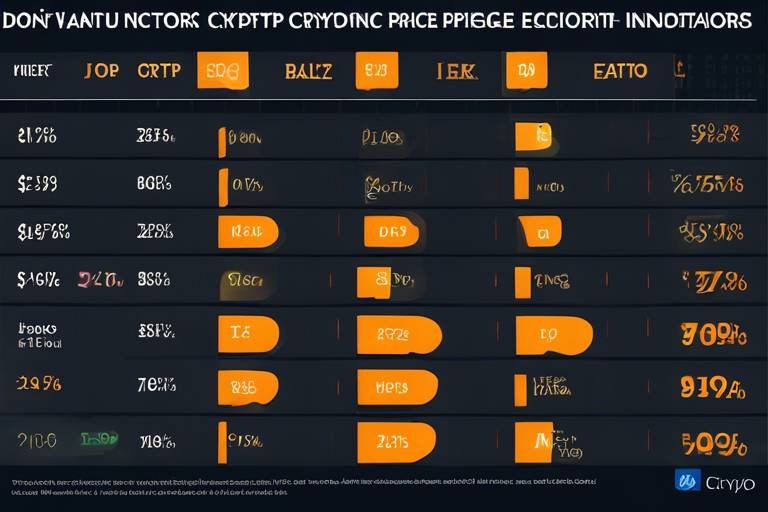How to Leverage Technical Analysis for Market Insights
In the fast-paced world of trading, having the right tools and knowledge can make all the difference. Enter technical analysis, a method that allows traders to evaluate securities through the lens of historical market activity. Imagine being able to predict market movements like a seasoned detective piecing together clues from a crime scene. That’s the power of technical analysis! It’s not just about crunching numbers; it’s about understanding the story behind those numbers and using that insight to make informed trading decisions.
At its core, technical analysis revolves around the idea that all relevant information is reflected in a security's price. This means that by studying price movements and trading volumes, traders can gain insights into future price movements. Unlike fundamental analysis, which focuses on a company's financial health and external economic factors, technical analysis is all about the charts and patterns. Think of it as reading the market's pulse—where the heartbeat is the price action and the rhythm is the volume.
So, how do traders leverage this powerful tool? It starts with understanding key indicators and chart patterns that reveal market sentiment and potential future movements. Whether you're a novice trader or a seasoned pro, mastering these elements can significantly enhance your trading strategy. By the end of this article, you’ll not only grasp the fundamentals of technical analysis but also learn how to apply these insights to your trading practices effectively.
But wait, there's more! The beauty of technical analysis is that it can be combined with other strategies to create a robust trading plan. Imagine being a chef who combines different ingredients to create a delicious dish; that’s how traders mix technical analysis with fundamental and sentiment analysis to get a full picture of the market. This holistic approach can lead to more informed and confident trading decisions.
As we dive into the world of technical analysis, prepare yourself for a journey filled with charts, indicators, and patterns that will help you navigate the complex waters of trading. Ready to uncover the secrets that lie within the price movements? Let’s get started!
- What is technical analysis? Technical analysis is a method used to evaluate securities by analyzing statistics generated from market activity, primarily price and volume.
- How does technical analysis differ from fundamental analysis? While technical analysis focuses on price movements and market trends, fundamental analysis evaluates a company's financial health and economic factors.
- What are some key indicators in technical analysis? Common indicators include moving averages, Relative Strength Index (RSI), and Moving Average Convergence Divergence (MACD).
- Can technical analysis predict future market movements? While it can provide insights and probabilities, no method can guarantee accurate predictions due to the unpredictable nature of markets.
- How can I combine technical analysis with other strategies? By integrating technical analysis with fundamental and sentiment analysis, traders can create a comprehensive trading strategy that takes multiple factors into account.

Understanding Technical Analysis
Technical analysis is like the detective work of the trading world. Instead of diving deep into a company's financial statements or economic indicators, traders focus on the price movements and trading volumes of securities. The core idea here is that all available information—whether it's news, earnings reports, or economic shifts—is already reflected in the price. So, why bother with the nitty-gritty details? Well, technical analysis allows traders to make sense of price data through patterns and trends, which can be incredibly insightful when making trading decisions.
The principles of technical analysis are built on the belief that markets move in trends and that historical price movements can help predict future behavior. Think of it like this: if you notice that a river flows in a certain direction, you can reasonably expect it to keep flowing that way unless something drastic changes. Similarly, traders use past price patterns to identify potential future movements. This contrasts sharply with fundamental analysis, where the focus is on a company’s intrinsic value, earnings, and overall economic conditions. While fundamental analysts might ask, “Is this stock undervalued?” technical analysts are more likely to ask, “What is the trend, and where is it headed?”
One key aspect of technical analysis is that it operates on the assumption that price movements are not random. Instead, they are influenced by a mix of psychological factors, market sentiment, and economic events. This means that by studying charts and indicators, traders can gauge the mood of the market and anticipate potential reversals or continuations in price trends. For instance, if a stock has been consistently rising and suddenly shows signs of weakness, a technical analyst might interpret this as a signal to sell, while a fundamental analyst might be looking for reasons to hold on.
In summary, understanding technical analysis is crucial for traders looking to navigate the complex waters of financial markets. It offers a unique lens through which to view market behavior, focusing on price movements rather than underlying fundamentals. By mastering technical analysis, traders can enhance their decision-making process and potentially increase their profitability. So, whether you’re a seasoned trader or just getting your feet wet, diving into the world of technical analysis can provide valuable insights into the ever-changing market landscape.

Key Indicators in Technical Analysis
When diving into the world of technical analysis, it's essential to understand that various indicators serve as the backbone of this approach. These indicators help traders interpret market movements and make informed decisions based on statistical data rather than just gut feelings. Think of them as the compass that guides you through the often turbulent waters of the financial markets. By utilizing these tools effectively, you can gain a clearer perspective on market trends and potential turning points.
Among the myriad of indicators available, some have proven to be particularly popular due to their effectiveness and ease of use. Here are a few key indicators that every trader should be familiar with:
- Moving Averages: These indicators smooth out price data to help identify trends over time.
- Relative Strength Index (RSI): This momentum oscillator measures the speed and change of price movements.
- Moving Average Convergence Divergence (MACD): A trend-following momentum indicator that shows the relationship between two moving averages of a security’s price.
Each of these indicators has its unique characteristics and applications. For instance, moving averages can be further divided into two primary types: the Simple Moving Average (SMA) and the Exponential Moving Average (EMA). The SMA is straightforward, calculating the average price over a certain period, while the EMA gives more weight to recent prices, making it more responsive to new information. This responsiveness can be particularly advantageous when trying to capture short-term price movements.
The Relative Strength Index (RSI) adds another layer of insight by helping traders identify whether a market is overbought or oversold. It operates on a scale of 0 to 100, with values above 70 typically indicating an overbought condition and values below 30 suggesting an oversold condition. Understanding these thresholds can help traders spot potential market reversals, making the RSI a crucial tool in their arsenal.
Finally, the MACD is a favorite among traders for its ability to provide both trend direction and momentum. By analyzing the convergence and divergence of two moving averages, traders can gain insights into potential buy or sell signals. When the MACD line crosses above the signal line, it often indicates a bullish trend, while a cross below can signal a bearish trend.
In summary, mastering these key indicators in technical analysis is vital for any trader looking to enhance their market insights. By understanding how to read and interpret these tools, you can improve your decision-making process and increase your chances of success in the ever-changing landscape of trading.
Q: What is the primary purpose of technical analysis?
A: The primary purpose of technical analysis is to evaluate securities by analyzing statistics generated from market activity, helping traders make informed decisions based on price movements and trends.
Q: How do moving averages help in trading?
A: Moving averages help traders identify trends over time by smoothing out price data, making it easier to spot potential buy or sell signals based on the direction of the average.
Q: What does the RSI indicate?
A: The Relative Strength Index (RSI) indicates whether a market is overbought or oversold, helping traders identify potential reversal points in the market.
Q: Why is the MACD considered a reliable indicator?
A: The MACD is considered reliable because it combines both trend direction and momentum, allowing traders to identify potential buy and sell signals through the analysis of moving averages.

Moving Averages
Moving averages are a fundamental tool in technical analysis, serving as a way to smooth out price data over a specific period of time. They help traders identify trends, as they filter out the "noise" from random price fluctuations. Think of moving averages as a gentle breeze that clears the fog, allowing you to see the underlying trend in the market more clearly. By looking at the average price over a defined period, traders can make more informed decisions about when to enter or exit a trade.
There are two primary types of moving averages that traders commonly use: the Simple Moving Average (SMA) and the Exponential Moving Average (EMA). Each has its unique characteristics and applications, making them suitable for different trading strategies. Understanding the differences between these two can significantly enhance your trading prowess.
The Simple Moving Average (SMA) is calculated by adding the closing prices of a security over a specific number of periods and then dividing by that number. For example, if you want to calculate a 10-day SMA, you would sum the closing prices of the last 10 days and divide by 10. The SMA provides a straightforward representation of the average price over that period, which can help traders identify potential buy or sell signals. When the price crosses above the SMA, it may indicate a buying opportunity, while a cross below could signal a potential sell.
On the other hand, the Exponential Moving Average (EMA) gives more weight to recent prices, making it more responsive to new information. This characteristic makes the EMA particularly useful for capturing short-term price movements. Traders often prefer the EMA when they want to react quickly to price changes. For instance, if a stock is experiencing a rapid upward trend, the EMA will reflect that change faster than the SMA, allowing traders to make timely decisions.
To illustrate the differences between SMA and EMA, consider the following table:
| Feature | Simple Moving Average (SMA) | Exponential Moving Average (EMA) |
|---|---|---|
| Weighting | Equal weight to all prices | More weight to recent prices |
| Responsiveness | Slower to react | Faster to react |
| Use Case | Longer-term trends | Shorter-term trends |
In summary, moving averages are indispensable tools for traders looking to understand market trends. By using both SMA and EMA, traders can gain a comprehensive view of price movements, allowing them to make more informed decisions. Whether you prefer the simplicity of the SMA or the responsiveness of the EMA, incorporating these moving averages into your trading strategy can enhance your ability to navigate the markets effectively.
- What is the main difference between SMA and EMA? The main difference lies in how they weight price data; SMA gives equal weight to all prices, while EMA gives more weight to recent prices, making it more responsive to recent market changes.
- How can I use moving averages in my trading strategy? Moving averages can be used to identify trends, generate buy or sell signals, and determine potential support and resistance levels.
- What time periods should I use for moving averages? The choice of time period depends on your trading style; shorter time periods (like 10 or 20 days) are typically used for day trading, while longer periods (like 50 or 200 days) are more suited for long-term investing.

Simple Moving Average (SMA)
The is one of the most widely used indicators in technical analysis, and for good reason! It provides a clear, straightforward method for smoothing out price data and identifying trends over a specified period. Essentially, the SMA calculates the average price of a security over a set number of days, which helps traders to gauge whether a stock is trending upwards, downwards, or sideways. This is crucial because understanding the trend can significantly influence trading decisions.
To calculate the SMA, you simply add up the closing prices of a security over a specific time frame and then divide that sum by the number of time periods. For example, if you wanted to calculate a 10-day SMA, you would take the closing prices from the last 10 days, sum them up, and divide by 10. The formula looks like this:
SMA (P1 + P2 + P3 + ... + Pn) / n
Where P represents the closing prices over the period, and n is the number of periods. The resulting value gives you the average price, which can be plotted on a chart to visualize the trend.
One of the significant advantages of using the SMA is its simplicity. However, it’s essential to remember that while it helps in identifying trends, it can also lag behind the price action, especially in volatile markets. This lag happens because the SMA equally weighs all prices in the period, making it less responsive to recent price changes. Therefore, traders often combine the SMA with other indicators to enhance their analysis. For instance, many traders look for crossovers between the SMA and the current price or other moving averages to identify potential buy or sell signals.
Here’s a quick look at how to interpret the SMA in your trading strategy:
- Buy Signal: When the price crosses above the SMA, it may indicate a potential buy opportunity.
- Sell Signal: Conversely, when the price crosses below the SMA, it could signal a sell opportunity.
- Trend Confirmation: If the price consistently remains above the SMA, it suggests a bullish trend, while a price consistently below indicates a bearish trend.
In summary, the Simple Moving Average is a fundamental tool in a trader's arsenal, offering a simple yet effective way to identify market trends. By understanding how to calculate and interpret the SMA, traders can make more informed decisions and potentially enhance their trading strategies.
- What is the best time period for calculating the SMA? The best time period depends on your trading style. Short-term traders might use a 10 or 20-day SMA, while long-term traders might prefer a 50 or 200-day SMA.
- Can the SMA be used in all markets? Yes! The SMA can be applied in various markets, including stocks, forex, and commodities.
- How does the SMA differ from the EMA? While the SMA gives equal weight to all prices in the period, the Exponential Moving Average (EMA) gives more weight to recent prices, making it more responsive to new information.

Exponential Moving Average (EMA)
The is a powerful tool in the arsenal of any trader looking to gain deeper insights into price movements. Unlike the Simple Moving Average (SMA), which gives equal weight to all price points in the selected period, the EMA places greater emphasis on the most recent prices. This characteristic makes the EMA more responsive to price changes, allowing traders to capture short-term trends more effectively. Imagine trying to catch a wave; the EMA is like a surfboard that adapts quickly to the shifting tides, ensuring you stay on top of the action.
To calculate the EMA, traders use a specific formula that incorporates the previous EMA value and the latest closing price. The formula is as follows:
EMA (Current Price x (k)) + (Previous EMA x (1 - k)) where k 2 / (N + 1)
Here, N represents the number of periods over which the EMA is calculated. The smaller the N, the more sensitive the EMA will be to price changes. This sensitivity is particularly beneficial for traders who engage in short-term trading strategies, as it helps them identify potential entry and exit points more swiftly.
One of the significant advantages of the EMA over the SMA is its ability to reduce lag, which is crucial in fast-moving markets. For instance, if a stock's price suddenly surges, the EMA will react more quickly compared to the SMA, potentially providing traders with earlier signals to buy or sell. This can be the difference between riding a profitable wave or missing out entirely.
Traders often use the EMA in conjunction with other indicators to enhance their strategies. For example, the EMA can be combined with the Relative Strength Index (RSI) to confirm trends. When the EMA indicates a bullish trend and the RSI supports this with values above 50, traders may feel more confident in their decision to enter a trade. Conversely, if the EMA shows a bearish trend while the RSI indicates overbought conditions, it might signal a good time to consider selling.
In summary, the Exponential Moving Average is not just a number on a chart; it's a dynamic indicator that helps traders navigate the complexities of the market. By focusing on recent price data, the EMA offers a clearer picture of current trends, making it an invaluable component of a trader's toolkit.
- What is the main difference between EMA and SMA? The main difference lies in how they weigh price data; EMA gives more weight to recent prices, making it more responsive to price changes.
- How can I use EMA in my trading strategy? You can use EMA to identify trends, confirm signals from other indicators, and set potential entry and exit points.
- Is EMA suitable for all types of trading? While EMA is particularly beneficial for short-term trading, it can be adapted for longer-term strategies as well, depending on the chosen period.

Relative Strength Index (RSI)
The is a pivotal tool in the realm of technical analysis, acting as a momentum oscillator that measures the speed and change of price movements. Essentially, it provides traders with insights into whether a security is overbought or oversold, which can be incredibly valuable for making informed trading decisions. The RSI operates on a scale from 0 to 100, with conventional thresholds set at 70 and 30. When the RSI exceeds 70, it suggests that the asset may be overbought, indicating a potential price reversal or correction. Conversely, an RSI below 30 suggests that the asset may be oversold, hinting at a possible upward price movement.
One of the remarkable aspects of the RSI is its ability to highlight divergences between price action and momentum. For instance, if a stock is making new highs while the RSI is failing to reach new highs, this bearish divergence can be a strong signal that the upward trend may be losing strength. Similarly, bullish divergence occurs when the price hits new lows but the RSI forms higher lows, suggesting a potential reversal to the upside. These divergences can be crucial indicators for traders looking to capitalize on market movements.
To effectively use the RSI, traders often look for specific patterns and signals. For example, when the RSI crosses above the 30 level, it can be interpreted as a bullish signal, while a drop below 70 can signal a potential bearish trend. However, it’s essential to combine the RSI with other indicators and analysis methods for a more comprehensive understanding of market dynamics. The following table summarizes the key RSI levels and their implications:
| RSI Level | Interpretation |
|---|---|
| Above 70 | Potentially Overbought |
| Below 30 | Potentially Oversold |
| 50 | Neutral |
In summary, the RSI is not just a standalone tool; it's a part of a broader toolkit that traders use to navigate the complexities of the market. By understanding how to interpret RSI values and recognizing divergences, traders can enhance their decision-making process and increase their chances of success. So, the next time you’re analyzing a potential trade, consider the RSI as a valuable ally in your trading strategy!
- What is the best period to use for RSI? Generally, a 14-day period is standard, but traders may adjust this based on their trading style.
- Can RSI be used for all types of securities? Yes, RSI can be applied to stocks, commodities, forex, and cryptocurrencies.
- How can I combine RSI with other indicators? Many traders use RSI alongside moving averages or MACD for a more robust analysis.

Chart Patterns and Their Significance
When it comes to trading, chart patterns play a pivotal role in helping traders predict future market movements. These visual formations on price charts can reveal a lot about market sentiment and potential price action. Understanding these patterns is like having a roadmap in the often chaotic world of trading. Just as a skilled navigator relies on maps to chart a course, traders depend on chart patterns to guide their decisions.
Chart patterns can be categorized into two main types: reversal patterns and continuation patterns. Reversal patterns signal that a trend is about to change direction, while continuation patterns indicate that the current trend is likely to persist. Recognizing these patterns can significantly enhance a trader's ability to make informed decisions. For instance, if a trader identifies a reversal pattern, they might consider exiting a position or adjusting their strategy to align with the new trend.
Let's delve into some of the most common chart patterns and their significance:
The head and shoulders pattern is one of the most recognized reversal patterns in technical analysis. It typically appears at the top of an uptrend and suggests that a bearish reversal is imminent. This pattern consists of three peaks: the left shoulder, the head, and the right shoulder. The left shoulder forms first, followed by a higher peak (the head), and then another lower peak (the right shoulder). Traders often look for a break below the neckline, which is drawn by connecting the lows of the two shoulders, to confirm the reversal.
Triangles are another significant chart pattern that indicates a period of consolidation before a breakout occurs. There are three main types of triangle patterns:
- Ascending Triangles: These patterns are bullish and are characterized by a flat upper trendline and an upward-sloping lower trendline. They suggest that buyers are gaining strength.
- Descending Triangles: These are bearish patterns with a flat lower trendline and a downward-sloping upper trendline, indicating that sellers are in control.
- Symmetrical Triangles: These patterns can break out in either direction and are formed when the price action creates converging trendlines. They show indecision in the market.
Understanding these patterns allows traders to anticipate potential breakouts and set their entry and exit points accordingly.
In summary, recognizing chart patterns is essential for traders seeking to navigate the complexities of the market. By analyzing these formations, traders can gain insights into potential price movements, enhancing their decision-making process. Whether it's the head and shoulders or triangle patterns, each provides valuable information that can lead to successful trades. Remember, the key is not just to identify these patterns but also to understand their implications and act accordingly.
Q: How reliable are chart patterns for predicting market movements?
A: While chart patterns can provide valuable insights, they are not foolproof. It's essential to combine them with other analysis techniques for more reliable predictions.
Q: Can chart patterns be used in any market?
A: Yes, chart patterns can be applied in various markets, including stocks, forex, and commodities. However, their effectiveness may vary based on market conditions.
Q: How can I practice identifying chart patterns?
A: You can practice by analyzing historical price charts, using trading simulators, or following real-time market data to spot patterns as they form.

Head and Shoulders
The head and shoulders pattern is one of the most recognized and reliable reversal patterns in technical analysis. It typically indicates a shift in trend direction, signaling that a bullish trend may be coming to an end and a bearish trend may be on the horizon. This pattern consists of three peaks: a higher peak (the head) between two lower peaks (the shoulders). Understanding how to identify this pattern can be a game-changer for traders looking to maximize their profits.
To spot a head and shoulders pattern, traders should look for the following characteristics:
- Left Shoulder: This forms when the price rises to a peak and then declines to a trough.
- Head: The price then rises again, surpassing the previous peak, before falling back down.
- Right Shoulder: Finally, the price rises again but fails to reach the height of the head, followed by a decline.
When the price breaks below the neckline, which is drawn by connecting the troughs of the left shoulder and the head, it confirms the pattern and signals a potential sell opportunity. The head and shoulders pattern can be visually represented as follows:
| Component | Description |
|---|---|
| Left Shoulder | First peak followed by a decline |
| Head | Highest peak followed by a decline |
| Right Shoulder | Second peak lower than the head followed by a decline |
| Neckline | Line connecting the troughs of the left shoulder and head |
But why is this pattern so significant? Well, it often suggests a loss of momentum in the current trend, which can lead to a more substantial price decline. Traders often use this pattern in conjunction with volume analysis; ideally, volume should decrease during the formation of the left shoulder and head, then increase during the breakdown below the neckline. This volume confirmation adds another layer of reliability to the pattern.
In summary, recognizing the head and shoulders pattern can provide traders with invaluable insights into potential market reversals. By understanding its formation and the implications of a breakout from the neckline, traders can position themselves to make informed decisions. Remember, though, like any trading strategy, it's essential to use this pattern in conjunction with other technical indicators and analysis methods to increase the probability of success.
What does the head and shoulders pattern signify?
The head and shoulders pattern indicates a potential reversal in the market trend, suggesting that a bullish trend may be ending and a bearish trend may begin.
How do I confirm a head and shoulders pattern?
Confirmation occurs when the price breaks below the neckline after the formation of the right shoulder, ideally accompanied by increased volume.
Can the head and shoulders pattern appear in both bullish and bearish trends?
Yes, there is an inverse head and shoulders pattern that forms in a bearish trend, indicating a potential reversal to bullish.

Triangles
When it comes to technical analysis, are among the most fascinating chart patterns that traders encounter. These patterns signify periods of consolidation, where the price of a security is squeezed into a tighter range before a breakout occurs. Understanding how to identify and interpret these formations can give traders a significant edge in predicting future price movements. Triangles can be categorized into three main types: ascending triangles, descending triangles, and symmetrical triangles. Each has its own unique characteristics and implications for trading strategies.
Let’s dive into each type of triangle:
- Ascending Triangle: This pattern is characterized by a flat upper trend line and a rising lower trend line. It typically indicates bullish sentiment, suggesting that buyers are gaining strength and may push the price higher. Traders often look for a breakout above the upper trend line as a signal to enter a long position.
- Descending Triangle: In contrast, the descending triangle features a flat lower trend line and a declining upper trend line. This pattern usually signals bearish sentiment, indicating that sellers are gaining control. A breakout below the lower trend line can be a strong signal for traders to consider shorting the asset.
- Symmetrical Triangle: This pattern is formed by converging trend lines, where both the upper and lower lines are sloping towards each other. It indicates indecision in the market, and traders often anticipate a breakout in either direction. The key is to wait for confirmation of the breakout before making a move.
Identifying these triangles on a price chart can be a game-changer for traders. But how do you spot them effectively? Look for the following:
| Triangle Type | Characteristics | Trading Implication |
|---|---|---|
| Ascending Triangle | Flat upper line, rising lower line | Potential bullish breakout |
| Descending Triangle | Flat lower line, declining upper line | Potential bearish breakout |
| Symmetrical Triangle | Converging lines | Indecision; breakout possible in either direction |
Once you recognize a triangle pattern, it’s crucial to monitor the volume accompanying the breakout. Typically, a breakout should be accompanied by an increase in volume, which adds credibility to the move. If the breakout occurs on low volume, it may indicate a false breakout, leading to potential losses.
In summary, triangles are powerful tools in a trader's arsenal. By understanding their structure and implications, traders can make more informed decisions and potentially capitalize on market movements. So, the next time you’re analyzing a chart, keep an eye out for these patterns—they might just lead you to your next profitable trade!
Q: How do I know if a triangle pattern is valid?
A: A valid triangle pattern should have at least two touches on each trend line. Additionally, look for converging lines and ensure that the price is consolidating within the pattern.
Q: What is the best way to trade a breakout from a triangle?
A: The best approach is to wait for a confirmed breakout above or below the triangle pattern, ideally accompanied by increased volume. Setting stop-loss orders just outside the triangle can help manage risk.
Q: Can triangles appear on different time frames?
A: Yes, triangles can form on various time frames, from minutes to daily charts. However, the significance of the pattern may vary depending on the time frame you are analyzing.

Combining Technical Analysis with Other Strategies
When it comes to trading, relying solely on one method can often lead to missed opportunities or misguided decisions. That's why can be a game-changer for traders looking to enhance their market insights. By integrating various approaches, you can create a more comprehensive trading strategy that not only considers price movements but also the underlying factors that drive those movements.
One of the most effective combinations is merging technical analysis with fundamental analysis. While technical analysis focuses on price patterns and trends, fundamental analysis digs deeper into a security's intrinsic value, taking into account economic indicators, earnings reports, and overall market conditions. For instance, if technical indicators suggest a bullish trend in a stock, but fundamental analysis reveals a declining earnings forecast, it might be wise to tread cautiously. This interplay can help traders make more informed decisions, balancing out the emotional highs and lows that often accompany trading.
Moreover, incorporating sentiment analysis can add another layer of depth to your trading strategy. Sentiment analysis gauges the mood of the market and investor behavior, providing insights into how other traders are feeling about a particular asset. By observing sentiment indicators—such as social media trends, news articles, and market surveys—you can better understand the psychology behind price movements. For example, if technical analysis shows a potential breakout but sentiment is overwhelmingly negative, it might signal a need for caution. Ultimately, blending sentiment analysis with technical indicators can help you gauge whether a price movement is backed by genuine interest or simply driven by hype.
To illustrate how these strategies can work together, consider the following table that outlines the key elements of each approach:
| Strategy | Focus | Key Indicators |
|---|---|---|
| Technical Analysis | Price movements and patterns | Moving Averages, RSI, MACD |
| Fundamental Analysis | Intrinsic value and economic factors | Earnings reports, P/E ratios, economic indicators |
| Sentiment Analysis | Market mood and investor behavior | Social media trends, news sentiment, surveys |
By employing a holistic approach that combines these strategies, traders can significantly improve their market predictions and decision-making processes. It’s like having a multi-faceted view of the market: while technical analysis shows you the "what," fundamental analysis reveals the "why," and sentiment analysis provides the "how." This synergy can lead to more robust trading strategies that adapt to the ever-changing market landscape.
In conclusion, don't limit yourself to just one analytical approach. Embrace the strengths of technical, fundamental, and sentiment analysis to create a well-rounded strategy that can better navigate the complexities of the trading world. After all, in trading, knowledge is power, and the more tools you have at your disposal, the better equipped you'll be to seize opportunities as they arise.
- What is technical analysis? Technical analysis involves evaluating securities by analyzing statistics generated by market activity, primarily price movements and trading volume.
- How does fundamental analysis differ from technical analysis? Fundamental analysis focuses on a security's intrinsic value by examining economic indicators, earnings, and overall market conditions, while technical analysis looks at price patterns and trends.
- What is sentiment analysis? Sentiment analysis gauges the mood of the market and investor behavior, often using social media trends and news sentiment to assess how traders feel about a particular asset.
- Can I rely solely on technical analysis for trading decisions? While technical analysis is a powerful tool, it's advisable to combine it with fundamental and sentiment analysis for a more comprehensive view of the market.

Fundamental Analysis
Fundamental analysis is a method used by traders and investors to evaluate a security's intrinsic value by examining related economic, financial, and other qualitative and quantitative factors. The core idea behind fundamental analysis is that a security is ultimately worth the present value of its expected future cash flows. This approach contrasts sharply with technical analysis, which focuses on price movements and trading volumes without considering the underlying value of the asset.
When diving into fundamental analysis, traders often look at several key elements to gauge a company's health and market potential. These include financial statements, economic indicators, and industry trends. Understanding these components can provide a clearer picture of whether a stock is undervalued or overvalued, helping traders make informed decisions. Here are some critical aspects to consider:
- Financial Statements: Analyzing a company's income statement, balance sheet, and cash flow statement is crucial. These documents provide insights into profitability, debt levels, and cash management.
- Economic Indicators: Metrics like GDP growth, unemployment rates, and inflation can significantly impact market performance. Traders must stay updated on these indicators to predict potential market movements.
- Industry Trends: Understanding the dynamics within a specific industry helps traders assess how external factors might influence a company's performance.
By integrating fundamental analysis with technical analysis, traders can develop a well-rounded trading strategy. For instance, while technical analysis might indicate that a stock is trending upwards, fundamental analysis could reveal that the company has strong earnings growth, validating the technical signal. Conversely, if the technical analysis shows a downward trend but fundamental analysis indicates a strong economic outlook, traders might consider it a buying opportunity.
In essence, combining both analyses allows traders to make more informed decisions. It's like having two sides of a coin; one side shows you the price action, while the other reveals the underlying value. This dual approach can enhance your trading strategy, providing a more comprehensive view of market movements.
As you embark on your trading journey, remember that mastering both technical and fundamental analysis is not just about crunching numbers or reading charts; it's about understanding the story behind the data. This holistic view can empower you to navigate the complexities of the market with greater confidence and precision.

Sentiment Analysis
Sentiment analysis is like the pulse of the market; it gauges the mood of investors and traders, providing a deeper understanding of market dynamics. Think of it as reading the room before making a big move—understanding whether the crowd is feeling bullish or bearish can significantly influence your trading decisions. This type of analysis goes beyond just numbers and charts; it taps into the psychological aspects of trading, which can often be the driving force behind price movements.
By evaluating sentiment, traders can identify potential market reversals or continuations. For instance, if a majority of investors are feeling optimistic about a stock, it might indicate a potential upward trend. Conversely, widespread pessimism could signal a downturn. But how do traders actually measure sentiment? Well, there are several methods and tools available that can help in this regard.
One of the most popular ways to gauge market sentiment is through various indicators and metrics. Here are a few key tools used in sentiment analysis:
- Surveys and Polls: These often gauge investor sentiment directly by asking participants about their market outlook.
- Social Media Monitoring: Platforms like Twitter and Reddit can provide real-time insights into public sentiment regarding specific stocks or the market in general.
- Market Sentiment Indicators: Tools like the Fear & Greed Index can help traders understand whether the market is in a state of fear or greed.
Incorporating sentiment analysis into your trading strategy can enhance your decision-making process. For example, if technical indicators suggest a bullish trend, but sentiment indicators show extreme fear among investors, it might be wise to proceed with caution. On the flip side, if sentiment is overwhelmingly positive, it can reinforce your confidence in a potential buy signal.
Moreover, sentiment analysis can also be combined with technical analysis to create a more robust trading strategy. By aligning sentiment with technical signals, traders can develop a comprehensive view of the market, allowing for more informed decisions. Imagine you’re sailing a ship; technical analysis provides the map, while sentiment analysis gives you the weather report. Combining both ensures that you navigate the waters effectively, avoiding storms and capitalizing on favorable winds.
In conclusion, sentiment analysis is an invaluable tool for traders looking to gain a competitive edge in the market. By understanding the emotional landscape of market participants, traders can make more informed decisions that align with prevailing market trends. This holistic approach not only enhances trading strategies but also fosters a deeper understanding of the market's ever-changing nature.
Q: What is sentiment analysis in trading?
A: Sentiment analysis in trading involves evaluating the mood of the market and its participants to predict future price movements. It considers psychological factors and investor emotions, providing insights beyond traditional technical or fundamental analysis.
Q: How can I measure market sentiment?
A: Market sentiment can be measured through various tools such as surveys, social media analysis, and sentiment indicators like the Fear & Greed Index. These methods help traders gauge whether the market is leaning towards optimism or pessimism.
Q: Can sentiment analysis be used with technical analysis?
A: Absolutely! Combining sentiment analysis with technical analysis can create a more comprehensive trading strategy. Technical analysis provides the data-driven insights, while sentiment analysis offers the emotional context, allowing for better-informed trading decisions.
Frequently Asked Questions
- What is technical analysis?
Technical analysis is a method used to evaluate securities by analyzing statistics generated from market activity, such as price movements and trading volume. Unlike fundamental analysis, which focuses on a company's financials and overall economic factors, technical analysis looks at historical price patterns to predict future movements.
- How do moving averages work?
Moving averages are used to smooth out price data over a specific period, helping traders identify trends. There are two main types: the Simple Moving Average (SMA), which calculates the average price over a set timeframe, and the Exponential Moving Average (EMA), which gives more weight to recent prices. This weighting makes EMA more sensitive to price changes, making it useful for short-term trading strategies.
- What is the Relative Strength Index (RSI)?
The RSI is a momentum oscillator that measures the speed and change of price movements. It ranges from 0 to 100 and helps traders identify overbought or oversold conditions in the market. Generally, an RSI above 70 indicates an overbought condition, while below 30 suggests an oversold condition, signaling potential market reversals.
- What are some common chart patterns?
Common chart patterns include head and shoulders, triangles, and flags. The head and shoulders pattern often indicates a trend reversal, while triangles signify consolidation before a breakout. Recognizing these patterns can help traders make informed decisions about entering or exiting trades.
- How can I combine technical analysis with other strategies?
Combining technical analysis with fundamental analysis and sentiment analysis can provide a more comprehensive trading strategy. While technical analysis focuses on price movements, fundamental analysis looks at a security's intrinsic value, and sentiment analysis gauges market mood. Together, these approaches can enhance decision-making and improve trading outcomes.
- Is technical analysis suitable for all types of traders?
Yes, technical analysis can be beneficial for various types of traders, including day traders, swing traders, and long-term investors. However, it's essential to adapt the techniques and indicators used based on individual trading styles and market conditions. Understanding your own trading goals and risk tolerance is crucial for effectively leveraging technical analysis.



















